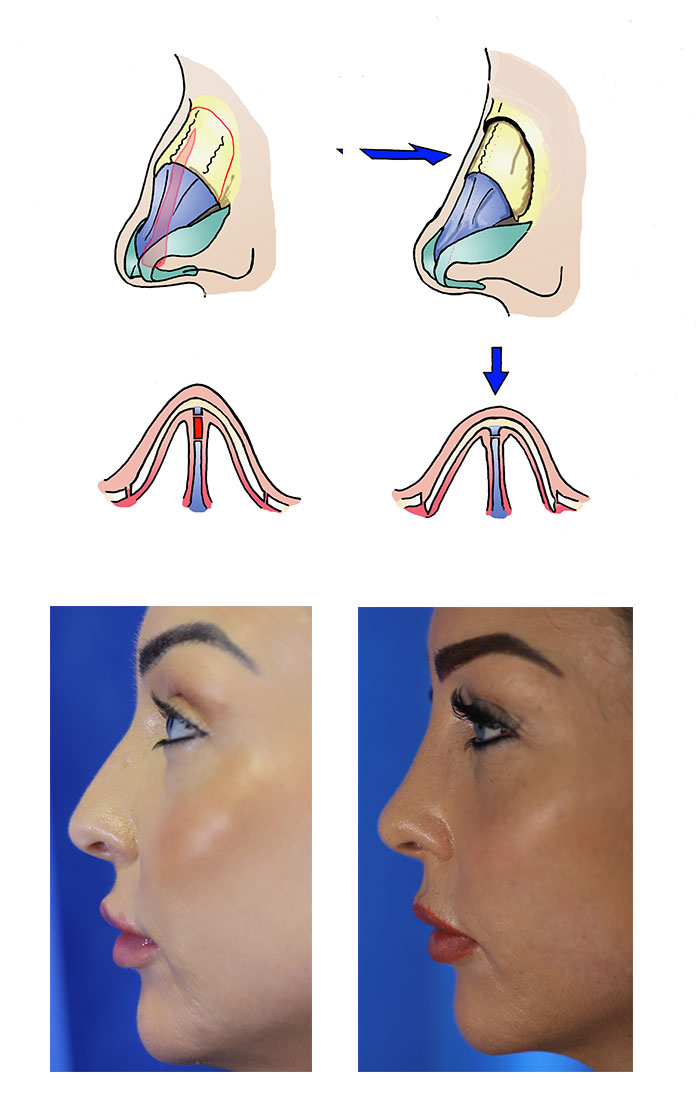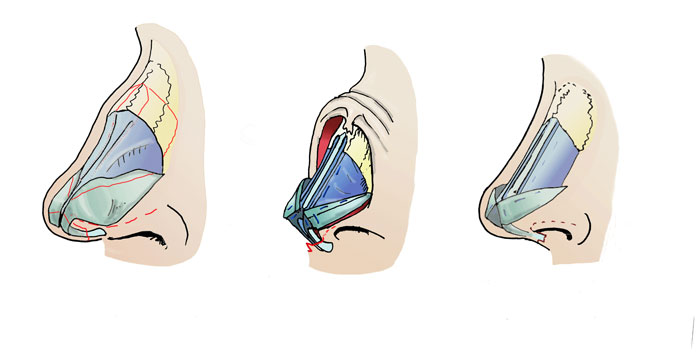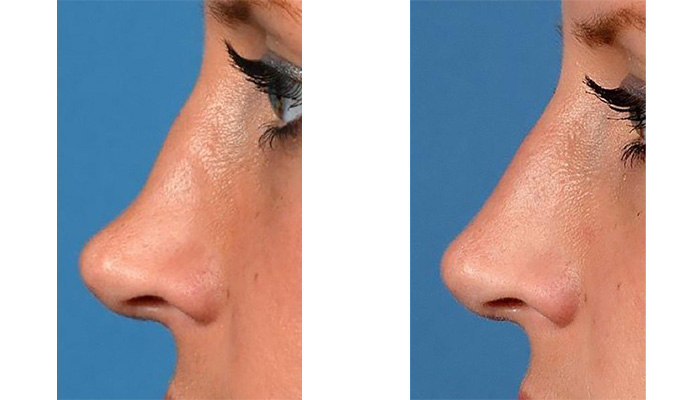Rhinoplasty (Nose Job) Surgery
The Consultation
At the consultation, expect to be asked details of your background medical history and particularly about any past history of nose trauma, nose bleeds, allergies, colds and other nasal problems. You will be asked how you and others perceive your nose and what effect it has on your self-confidence and day to day life. You will be asked about your motivation to seek a rhinoplasty and if you have a history of psychological or mental health problems.
Significant psychological or psychiatric problems and over-preoccupation or obsession with your appearance should be addressed before surgery is contemplated. A rhinoplasty will never solve these issues and in some cases may make matters worse.
A detailed examination of the outside and inside of your nose will be carried out and photographs will be taken. In most cases a second consultation will be organised and the photographs will then be discussed in greater detail. A simulation rhinoplasty, using ‘morphing’ software to illustrate planned changes can be helpful. This reduces misunderstanding between you and the surgeon as to what you are hoping to achieve and what the surgeon thinks is possible to achieve. Sometimes a CT scan of your nose and face are required. A detailed plan is drawn up of the technical steps required to achieve the result. You will be given a very detailed and long consent form which you can read at your leisure. This form must be signed before surgery, you can keep your own copy.
GDPR
Your data is stored according to GDPR guidelines. Photographs are required as essential records and are an integral part of the planning process for rhinoplasty. However, facial photographs are recognisable and confidential and therefore cannot be released into the public domain. We take your written consent to store your photographs. Your images are stored in an encrypted and secure manner.
The Operation, Procedure
On the day of surgery, you will be assessed by your anaesthetist, who will check that you do not have a cold or are recovering from a cold or recent chest infection. If this is the case it is usually unwise to proceed.
Your hospital admission is usually overnight. When you wake you will have a splint on your nose and your nostrils will be blocked with dissolving packs. The stitches are also dissolving and don’t need to be removed unless they are causing irritation. Occasionally special bolster stitches are used which come out after a week.
After discharge, the following day you will be given an appointed for a week. The splint will be removed at that stage, although you may have steristips on your nose for a further week. You will also be reviewed at the six-week stage and as many further times as are required.
DIFFERENT TYPES OF RHINOPLASTY
Closed, Preservation Rhinoplasty
Patients who are requesting very straightforward reduction of a humped nose or the overall size of the nose but otherwise have a relatively straight nose and a normal tip can have a closed rhinoplasty. A small amount of tip work and minor deviation can be corrected with this method. In this procedure a strip of septum is removed, and the nasal bones are mobilised. the dorsum of the nose can then be pushed backwards reducing its prominence and eliminating the hump. The cuts are made inside the nostrils to allow access to the structures inside. In the last few years this form of rhinoplasty has generated great interest among patients and surgeons as there is less swelling and a faster recovery time. However, it is only suitable for more minor cases.

Open Rhinoplasty
Patients with more complicated situations, such as a large nose, a crooked nose or a badly shaped tip usually require an open rhinoplasty. This technique involves a small incision across the piece of skin which lies between the nostrils (the columella). The skin of the nose can then be lifted like the bonnet of a car. The entire structure of the nose can then be worked upon under direct vision. The alar cartilages that make up the tip can be reshaped in a much more controlled way using this technique. A much better view of the septum can also be achieved and it is therefore much easier to correct a crooked septum by this technique. This technique involves disassembling the nose and reassembling each component. We make extensive use of cartilage grafts ,(taken from the septum, ear or rib), and special stitches to achieve long term stable results that were previously hard to achieve. Sometimes the septum is very twisted or even crumpled. The open technique allows full access to the septum and it can be taken out completely and reshaped and replaced.( Extra Corporeal Septoplasty)

Grafts
It may be necessary to import tissue into the nose to support changes and cover imperfections. Cartilage grafts are most often harvested from the back of the septum. Sometimes there is not sufficient material in the back of the septum and cartilage is then taken from the ear; conchal cartilage graft, or rib; costal cartilage. These cartilage grafts are used to support straightening or lengthening of the of the septum; septal grafts. To protect the airways ; spreader grafts. Or to support the tip; columellar strut graft, tip grafts.
A thin layer of padding may be used to achieve a smooth result, such as a fascial graft or dermal-fat graft from the groin crease.
Grafts improve the control and reliability of the results.
Liquid Rhinoplasty, Fillers
This technique is very useful for small defects. It is quick with very little down-time, can be done in clinic and relatively inexpensive. Unfortunately, it is not permanent and only lasts about nine to twelve months. It is not suitable for larger problems. It can be done as an ‘experiment to see how you like the effect before embarking on surgery. It is a very helpful technique in dealing with minor irregularities, after surgery, if you are not satisfied.
Often, after a few treatments, some permanent effects can be seen and it doesn’t need to be used any more. Alternatively , a more permanent type of filler can be used in the form of the persons own fat; lipofilling. This is minor surgery but needs to be done in the hospital.

Complications and FAQ
Patients will very frequently have swelling and black eyes after this operation, although the extent of this varies considerably from patient to patient. While the packing can be uncomfortable, it is surprising how little pain most patients describe after this operation. However, of course a small number of patients find it painful and complain of nose pain and of headaches in particular.
Bleeding
While most patients bleed a little bit immediately after surgery, about 1 in 20 will bleed quite considerably and will require repacking of the nose. Very rarely patients may have to go back to theatre for cautery of the internal lining of their nose. It is very inadvisable to do any exercise or heavy work in the first week after the operation and these activities should only be gradually phased in during the following weeks. Bending down, nose blowing , sneezing through the nose and taking hot baths have also been reported to cause nose bleeds in the first few weeks after a rhinoplasty and obviously should be avoided.
Infection
In a standard rhinoplasty, It is quite rare to get a significant infection in the skin after this operation. However, if it does happen it may be associated with bleeding. These infections usually respond to antibiotics, however further surgery may be required in some cases of infection. Infection may leave scarring on the nose.
Infection is a particular problem in the presence of large cartilage grafts. Sometimes the grafts have to be removed to allow the infection to settle, which will obviously have a negative effect on the result. This situation will likely require revision surgery.
Numbness
Most patients will have a slightly numb tip after the operation, particularly if they have had an open rhinoplasty. However, this usually recovers.
Scars
The scars from closed rhinoplasty are usually not visible although very rarely these scars can tighten and cause the nostril to close off a little and on rare occasions this might have to be fixed surgically. The scar across the columella after an open rhinoplasty is usually excellent but on rare occasions it may be visible and obvious and may require some further treatment. Occasionally small scars on the side wall or due to internal skin damage can be visible, but we do try to avoid this if possible.
Cosmetic issues
The biggest problem and most common complaint after rhinoplasty, is dissatisfaction with the final result, and this can occur in 1 in 10 cases. Sometimes this is because patients’ expectations have been too high or that the patient and the surgeon have slightly misunderstood each other as to what the patient requires. However, most of the time the problem is due to the slightly unpredictable nature of the healing process. Occasionally a hump can come back with thickening of the nasal bones in the area of the hump due to over-active bone healing at this site. Occasionally thickened scar tissue develops under the skin that prevents the nose from shrinking down to the desired size and sometimes the nasal skin itself is so thick that it doesn’t shrink properly, leading to a disappointing result.
Other minor problems include, irregularities such as small nodules which you can feel under the skin in the area where the nasal bones have been broken or sometimes the nasal bones don’t break as evenly as expected, leading to slight crookedness in this area.
In the case of twisted noses, it is quite common for deviation to partially recur over the following year, this is because of the ‘memory ‘ property of cartilage which can be unpredictable. Asymmetrical nostrils are particularly difficult to correct and a little nostril asymmetry is also common. Clearly, if it is very obvious , revision will be suggested.
Any one of these problems may lead the patient to request a revision. This is often possible to do and usually successful.
FAQ’s
When will I be able to face the world?
All patients wear a splint and strapping across the nose for a week, during which time most people prefer not to be seen. In the following week there may still be swelling and bruising. This can often be covered with make-up in women and fortunately is not often as obvious in men. By the third week, while there is still often some residual swelling, it is not terribly obvious and most people return to work or their original activities. Some patients don’t want it too obvious to colleagues and friends that they have had a rhinoplasty. It is surprising how unobservant people can be and often subtle changes of rhinoplasty go unnoticed. It has been suggested that a change in hairstyle at around this time can often distract from the rhinoplasty so while people realise that something has changed, attention is drawn away from the nose.
Dos and don’ts once I have left hospital?
It is quite common to have minor bleeding from the nose the first few days after the operation. This should be gently dabbed away with tissues. It is important not to sneeze or blow your nose during this period. In addition, it is very unwise to take any exercise and you should avoid having hot baths and bending down. At night-time it is recommended that you prop your head up with more pillows as this can help clear the airways quicker and promote rapid settling of the post-operative swelling. There are often crusts and dried blood inside the nostrils and it is important not to pick at these as they can cause bleeding. If it becomes very irritating, it can be softened using vaseline or antibiotic ointment.
When do I get to see the final result?
It can take many weeks for the initial swelling to settle and then many months for the scar tissue underneath the skin to begin to soften so the skin is supple once again. This means that the final appearance of the nose may take many months to develop. In most cases, the nose improves with time. However occasionally, and particularly in the upper third of the nose where bony work has occurred, there can be worsening of the appearance with time due to development of bony lumps around the fracture sites. This can also mean that the original hump that was removed can recur to a certain extent in the unlucky few. Having said this, it is usually pretty apparent, even after a few weeks, how the nose is going to look and the final changes that occur over the subsequent few months are usually small and subtle. Most patients are satisfied with their rhinoplasty but it is important for those who are not entirely happy to wait at least six months, if not a year, for the appearance of the nose to stabilise before you can make a final decision.
